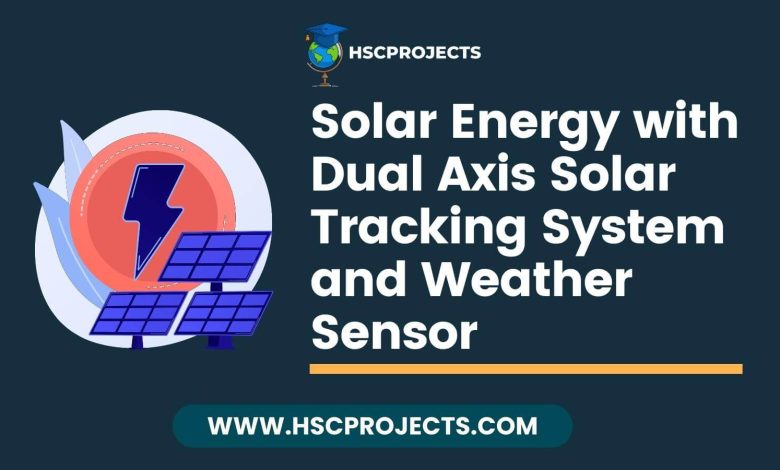
Solar Energy with Dual Axis Solar Tracking System and Weather Sensor
Introduction
Solar energy is rapidly becoming a cornerstone of renewable energy solutions worldwide. One of the most effective ways to maximize the energy harvested from the sun is through the use of solar tracking systems. This article delves into the design and implementation of a dual axis solar tracking system that not only follows the sun but also incorporates weather sensors for a more comprehensive energy solution.

Why Dual Axis?
A dual axis solar tracker has the ability to move in multiple directions, allowing it to capture more sunlight than a single-axis tracker. This increased efficiency makes dual axis solar tracking systems highly desirable for maximizing solar energy capture.
Core Components
The hardware specifications for this project include:
- Atmega Microcontroller
- Solar Panel
- Servo Motor
- DC Motor
- Rain Sensor
- Humidity Sensor
- Temperature Sensor
- Resistor
- Capacitors
- Transistors
- Cables and Connectors
- Diodes
- PCB and Breadboards
- LED
- Transformer/Adapter
- Push Buttons
- Switch
- IC
- IC Sockets
How it Works
The dual axis solar tracker is powered by an Arduino microcontroller that controls both a servo motor and a DC motor. These motors move the solar panel to follow the sun’s path across the sky. Additionally, the system incorporates a rain sensor, temperature and humidity sensors, which are displayed on an LCD. This allows for real-time monitoring of environmental conditions, making the system not just an automatic solar tracker but also a comprehensive weather station.
Applications
The applications of this dual axis solar tracking system are vast. From large-scale solar farms to small residential installations, this system can significantly increase the efficiency of solar energy capture. Moreover, the inclusion of weather sensors adds an extra layer of functionality, making it ideal for agricultural and meteorological applications.
Conclusion
The dual axis solar tracking system offers a robust and efficient way to maximize solar energy capture. Its Arduino-based control system and the inclusion of weather sensors make it a versatile solution for a variety of applications. Whether you’re a hobbyist or a professional, this solar tracker project provides a comprehensive approach to renewable energy and environmental monitoring.
Sample Code
#include <Servo.h>
#include <DHT.h>
#define DHTPIN 2
#define DHTTYPE DHT11
#define RAIN_SENSOR A0
Servo xServo; // X-axis servo
int dcMotorPin = 9; // Y-axis DC motor
DHT dht(DHTPIN, DHTTYPE);
void setup() {
Serial.begin(9600);
xServo.attach(8); // attach servo on pin 8
pinMode(dcMotorPin, OUTPUT);
dht.begin();
pinMode(RAIN_SENSOR, INPUT);
}
void loop() {
// Read temperature and humidity
float h = dht.readHumidity();
float t = dht.readTemperature();
// Read rain sensor
int rainValue = analogRead(RAIN_SENSOR);
// Print weather data to Serial Monitor
Serial.print("Humidity: ");
Serial.print(h);
Serial.print(" %\t");
Serial.print("Temperature: ");
Serial.print(t);
Serial.print(" *C ");
Serial.print("Rain: ");
Serial.println(rainValue);
// Simulate solar tracking (replace with actual tracking logic)
for (int pos = 0; pos <= 180; pos += 1) {
xServo.write(pos);
delay(15);
}
for (int pos = 180; pos >= 0; pos -= 1) {
xServo.write(pos);
delay(15);
}
// Simulate DC motor for Y-axis (replace with actual tracking logic)
analogWrite(dcMotorPin, 128); // half speed forward
delay(2000);
analogWrite(dcMotorPin, 0); // stop
delay(2000);
}
In order to download the PDF, You must follow on Youtube. Once done, Click on Submit
Follow On YoutubeSubscribed? Click on Confirm
Download Solar Energy with Dual Axis Solar Tracking System and Weather Sensor PDF






